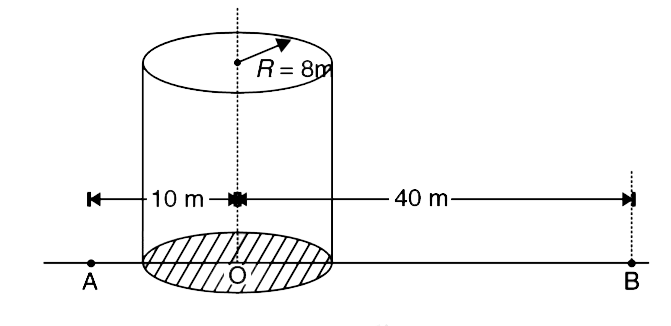An adult weighing 600 N raises the centre of gravity of his body by 0.25 m while taking each step of 1 m length in jogging. If he jogs for 6 km, the energy utilised by him in jogging is
9×106 J
9×105 J
6×106 J
6×105 J
The correct Answer is:B
Here, mg = 600 N, h = 0.25 m
Length of each step = 1 m
∴ No of steps in 6 km is N=6×103m1m=6000
∴ Energy utilised in jogging is
E=Nmgh=6000×600N×0.25m=9×105J
Topper's Solved these Questions
- WORK , ENERGY AND POWERBOOK - NCERT FINGERTIPSCHAPTER - WORK , ENERGY AND POWEREXERCISE - Power
13 Videos
- WORK , ENERGY AND POWERBOOK - NCERT FINGERTIPSCHAPTER - WORK , ENERGY AND POWEREXERCISE - Collisions
15 Videos
- WORK , ENERGY AND POWERBOOK - NCERT FINGERTIPSCHAPTER - WORK , ENERGY AND POWEREXERCISE - The Potential Energy Of A Spring
6 Videos
- WAVESBOOK - NCERT FINGERTIPSCHAPTER - WAVESEXERCISE - Assertion And Reason
15 Videos
Similar Questions
An adult weighing 600N raises the centre of gravity of his body by 0.25m while taking each step of 1m lenth in jogging. If he jogs for 6km, calculate the energy utilised by him in jogging assuming that there is no energy loss dur to friction of ground and air. Assuming that the body of the adult is capable of converting 10% of energy intake in the form of food, calculate the energy equivalent fo food that would be required to compensate energy utilised for jogging.
View SolutionA string can withstand a tension of 25 N. What is the greatest speed at which a body of mass 0.5 kg can be whirled in a circle using 0.5 m length of the string ? Neglect the force of gravity on the body.
View Solution
Knowledge Check
A man weighing 60 kg climbs up a staircase carrying a load of 20 kg on his head. The staircase has 20 steps each of height 0.2 m. If he takes 10 s to climb, find his power.
A313.6 WB120.6 WC510 WD0A bullet of mass 0.01kg and travelling at a speed of 500ms−1 strikes a block of mass 2kg which is suspended by a string of length 5m. The centre of gravity of the block is found to raise a vertical distance of 0.2m. What is the speed of the bullet after it emerges from the block?
A15ms−1B20ms−1C100ms−1D50ms−1In a second ODI match between England and India Bhuwnesh kumar bowled his medium fast bowling. He starts his run up from the distance of 50m from the stumps (bowling end) and at the time of bowling a ball,his speed is 36(km)/(hr) and the speed of ball is 144(km)/(hr).
If his mass is 70kg and mass of the ball is 14kg and the heat produce in his body is one tenth of the total work done by him, then
Energy spent by bowler in throwing one ball is :−A3500 JB200 JC4070 JD3700 J
A man weighing 60kg f suports a body of 20kgf on his head. Calculate work done by him in moving a distance of 15m up an incline of 1 in 10 . Take g=9.8m/s2
View SolutionIn order to make a jump straight up, a 60kg player starts the motion crouched down at rest. He pushes hard against the ground, raising his centre of mass by a height h0=0.5m. Assume that his legs exert a constant force F0 during this motion. At this point, where his centre of mass has gone up by h0 his feet leave the ground and he has an upward velocity of v. Centre of mass of his body rises further by h=0.8m before falling down [Take g=10m/s2]
(a) Find v.
(b) Find the normal force applied by the ground on his feet just before he left the ground.
View SolutionA string of length 40 cm and weighing 10 g is attached to a spring at one end and to a fixed wall at the other end. The spring has a spring constant of 160Nm−1 and is stretched by 1-0 cm. If a wave pulse is produced on the string near the wall, how much time will it take to reach the spring ?
View SolutionThere is a tall cylindrical building standing in a field. Radius of the cylinder is R=8m. A boy standing at A (at a distance of 10 m from the centre of the cylindrical base of the building) knows that his friend is standing at B behind the building. The line joining A and B passes through the centre of the base of the building. Distance between A and B is 50 m. A wants to throw a ball to B but he realizes that the building is too tall and he cannot throw the ball over it. He throws the ball at a speed of 20m/s such that his friend at B has to move minimum distance to catch it.

(a) What is the minimum distance that boy at B will have to move to catch the ball?
(b) At what angle to the horizontal does the boy at A throws the ball? Assume that the ball is released and caught at same height above the ground.
[Take g=10m/s2 and sin−1(0.75)≅48.6∘
View SolutionA car weighs 1800 kg. The distance between its front and back axles is 1.8 m. Its centre of gravity is 1 m behind the front axle. The force exerted by the level ground on each front wheel and each back wheel is (Take g:10ms−1)
View Solution
